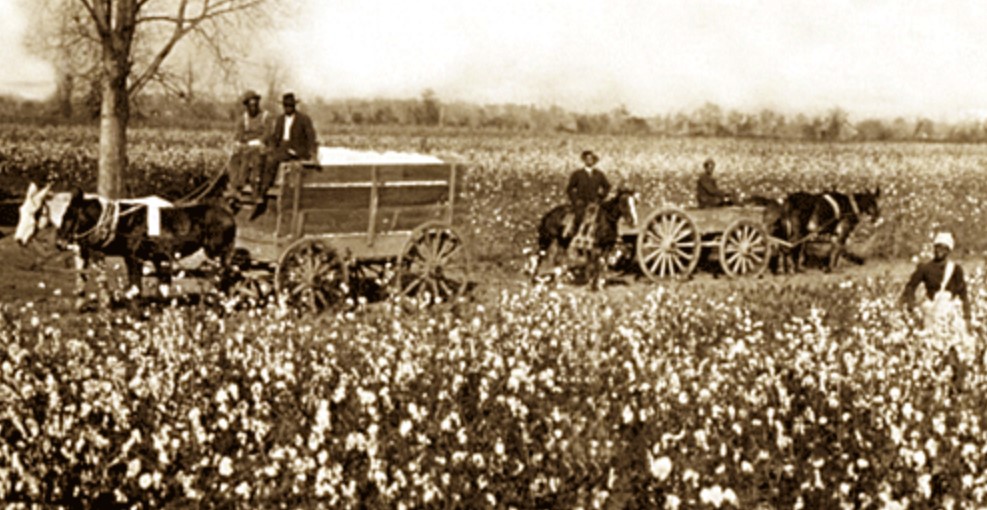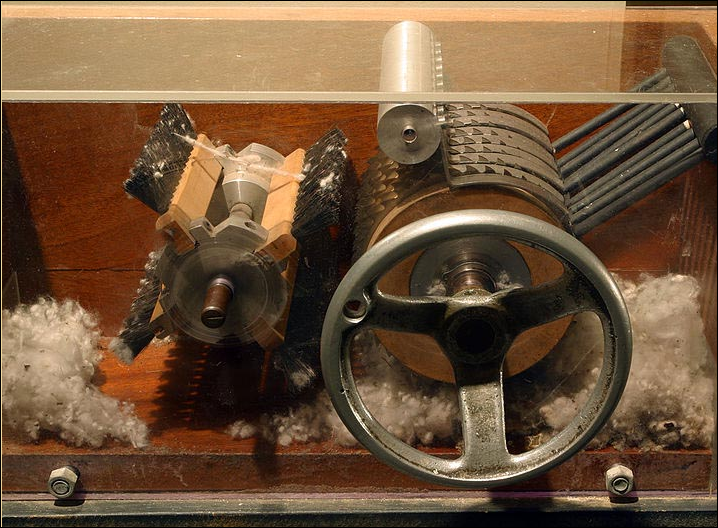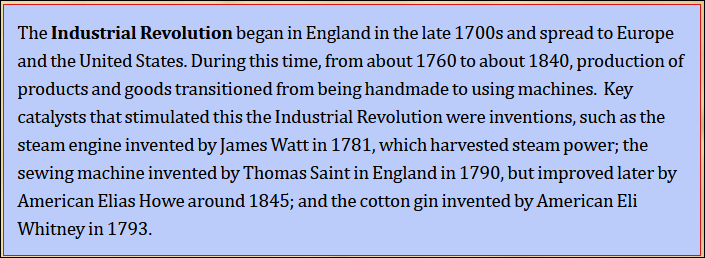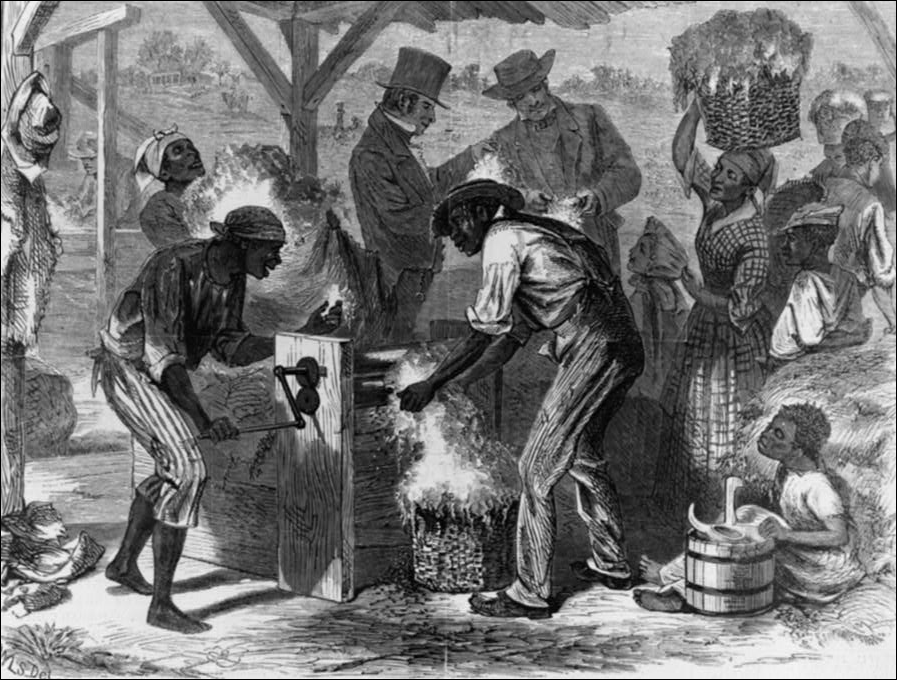 By Neenah Payne
By Neenah Payne
The Muslim Agricultural Revolution points out that Arabs introduced cotton to Europe — and thus to America.
The Turbulent Reign of King Cotton: The Dark History of One of the World’s Most Important Commodities by Harvard University explains the central role of cotton to the Industrial Revolution:
If not for cotton, we would still be wearing wool. To equal current cotton production, we would need seven billion sheep, and a field 1.6 times the area of the EU. Capitalism has spared us this itching, bleating nightmare. But capitalism, Sven Beckert writes in his hair-shirted history, Empire of Cotton, has wrought other horrors.
For medieval Europeans, cotton was a luxury import. Prices fell as Europe’s maritime empires bypassed the Ottoman middleman. They fell further after the 1780s, when the East India Company increased its imports, and British inventors developed water-powered spinning machines. Cotton became the first global commodity, woven into the ‘triangular trade’ that shuttled African slaves to New World plantations, New World materials to Europe, and finished goods from Europe to imperial markets.
These exchanges drew the cotton economy away from the coasts of south Asia and towards the Atlantic. In Britain, they turned Manchester into ‘Cottonopolis’, and created a class of ‘cotton capitalists’ who reinvested their profits in the Industrial Revolution. Their business also fuelled the growth of state power. In mercantilist style, government and private capital collaborated: Royal Navy ships escorted the private fleets of the East India Company.
When it comes to washing capitalism’s dirty laundry, nothing bloodies the water like ‘white gold’. Beckert calls mercantilism ‘war capitalism’, and violence the ‘fundamental characteristic’ of its ‘project’. This is polemical, and woolly.
The 18th-century British state grew by war, and its economy by cotton, but the interests of ministers and merchants were not identical, and rarely formed a coherent ‘project’. Most of Britain’s wars were against France, not for cotton. Many of Britain’s clients in African slavery and Indian cotton were willing partners.
Between 1780 and 1815, as Britain took control of the global cotton market, the state acted repeatedly against the cotton interest and its political connections: in the India Act of 1784, in the impeachment in 1788 of Warren Hastings, and, in 1807, by abolishing slave trading in the British empire. Beckert does not mention these theoretical anomalies.
By 1861, raw cotton constituted 61 per cent of American exports. Slaves picked 80 per cent of the cotton spun in British mills: while the British state interdicted slave ships, its merchants profited at one remove. Slavery, Beckert writes, was central to ‘the most dynamic and far-reaching production complex in human history’ — and in conflict with the ‘free land and free labour’ principles of the industrialising northern states. The outbreak of the American civil war caused a global panic, and riots in Lancashire. Yet the empire of cotton survived the dethronement of King Cotton. Imports from India and Egypt made up the deficit, and mechanical spindles reduced production costs.
The cotton economy rebuilt itself for industrial capitalism. Aided by the railroad, American cotton production thrived. Enfranchised slaves became share-croppers and mill hands. In 1861, the southern states had only produced cotton. In 1910, they were the world’s third largest cotton manufacturing area, after Britain and the northern states. Meanwhile, rising demand led to the implantation of modern production methods in Central Asia, Korea, West Africa and India.
As strikes and unionisation raised labour costs in America and Europe, cotton production swung back to Asia. Industrial cotton, a mainstay of capitalism, became the hope of the anti-imperialists. The West had lost its monopoly on ‘dark, satanic mills’, and so had capitalism. Gandhi, copying the northern abolitionists of the 1850s, had donned homespun linen to escape the cotton economy, but the spinning wheel became only a symbol on the Indian flag. In the 1950s, India’s socialist planners imitated capitalist infrastructure, while failing to emulate the variety or quality of its products. Nasser’s ‘Arab socialism’ did little better in Egypt, and the communists in Russia and China did much worse. Beckert describes their vicious bumblings as ‘a sharpening of tools and an enhancing of the methods of industrial capitalism’.
Today, half the world’s cotton is grown in China and India, and 80 per cent of it is processed in Asia. Heavily subsidised American farmers grow 14 per cent of the global supply. The mills of America and Europe are derelict, or repurposed as lofts and museums. Oil, having outstripped cotton as a commodity, is replacing cotton as a fabric, too: the market in petroleum-based synthetics is worth twice as much as the cotton market.
Still, cotton production is expected to quadruple by 2050. If we revert to wool, that means 28 billion sheep, and a field six times larger than the EU. ‘Capitalism,’ Beckert confesses, ‘has never been matched by any other system of production.’
Empire of Cotton: A Global History
Amazon Description
ONE OF THE NEW YORK TIMES 10 BEST BOOKS OF THE YEAR
WINNER OF THE BANCROFT PRIZE
PULITZER PRIZE FINALISTThe epic story of the rise and fall of the empire of cotton, its centrality to the world economy, and its making and remaking of global capitalism.
Cotton is so ubiquitous as to be almost invisible, yet understanding its history is key to understanding the origins of modern capitalism. Sven Beckert’s rich, fascinating book tells the story of how, in a remarkably brief period, European entrepreneurs and powerful statesmen recast the world’s most significant manufacturing industry, combining imperial expansion and slave labor with new machines and wage workers to change the world.
Here is the story of how, beginning well before the advent of machine production in the 1780s, these men captured ancient trades and skills in Asia, and combined them with the expropriation of lands in the Americas and the enslavement of African workers to crucially reshape the disparate realms of cotton that had existed for millennia, and how industrial capitalism gave birth to an empire, and how this force transformed the world.
The empire of cotton was, from the beginning, a fulcrum of constant global struggle between slaves and planters, merchants and statesmen, workers and factory owners. Beckert makes clear how these forces ushered in the world of modern capitalism, including the vast wealth and disturbing inequalities that are with us today. The result is a book as unsettling as it is enlightening: a book that brilliantly weaves together the story of cotton with how the present global world came to exist.
New York Times Review
‘Empire of Cotton,’ by Sven Beckert
By Adam Hochschild
The history of an era often seems defined by a particular commodity. The 18th century certainly belonged to sugar….In the 20th century and beyond, the commodity has been oil: determining events from the Allied partitioning of the Middle East after World War I to Hitler’s drive for Balkan and Caspian wells to the forging of our own fateful ties to the regimes of the Persian Gulf.
In his important new book, the Harvard historian Sven Beckert makes the case that in the 19th century what most stirred the universe was cotton….“Until the 19th century,” Beckert explains, “the overwhelming bulk of raw cotton was spun and woven within a few miles from where it was grown.” Nothing changed that more dramatically than the slave plantations that spread across the American South, a form of outsourcing before the word was invented. These showed that cotton could be lucratively cultivated in bulk for consumers as far afield as another continent, and that realization turned the world upside down.
Without slavery, he says, there would have been no Industrial Revolution.
Beckert’s most significant contribution is to show how every stage of the industrialization of cotton rested on violence. As soon as the profit potential of those Southern cotton fields became clear in the late 1780s, the transport of slaves across the Atlantic rapidly increased. Cotton cloth itself had become the most important merchandise European traders used to buy slaves in Africa. Then planters discovered that climate and rainfall made the Deep South better cotton territory than the border states. Nearly a million American slaves were forcibly moved to Georgia, Mississippi and elsewhere, shattering many families in the process.
The search for more good cotton-growing soil in areas that today are such states as Texas, Arkansas, Kansas and Oklahoma was a powerful incentive to force Native Americans off their traditional lands and onto reservations, another form of violence by the “military-cotton complex.” Beckert’s coinage seems not far-fetched when he points out that by 1850, two-thirds of American cotton was grown on land that had been taken over by the United States since the beginning of the century. And who structured the bond deal for the Louisiana Purchase, which made so much of that possible? Thomas Baring of Britain, one of the world’s leading cotton merchants. …
And it was not only white Southerners who were responsible for the harsh regime of slave-grown cotton: merchants and bankers in the North and in Britain lent them money and were investors as well. With sons strategically stationed in cities on both sides of the Atlantic, the Brown family — patrons of the Museum of Natural History in New York and the corporate ancestors of Brown Brothers Harriman — owned more than a dozen Southern cotton plantations outright.
King Cotton: White Gold
The title, King Cotton, comes from the fact that cotton was the major export of the United States in the early 1800s just prior to the Civil War time frame. By the 1850s, the cotton grown, shipped, and sold by southerners was worth more than all the rest of America’s exports put together.
As the primary crop, cotton overtook tobacco, which had been planted and depleted many of the minerals in the soil. When the Constitution was ratified and went into effect in 1789, tobacco was the most important crop grown in the South. Also, Thomas Jefferson and many other people, in the South as well as the North, thought that slavery would soon disappear in the United States. However, the invention of the cotton engine (shortened to “gin”) revolutionized cotton production. Cotton became the most valuable crop grown at that time—the intrinsic value of cotton then is comparable to the intrinsic value of oil today. It became an economic as well as political instrument…
The Gin’s Legacy
After Eli Whitney invented the cotton gin in 1793, cotton grew in popularity and use and became a treasured worldwide commodity in the early 1800s. By the time of the Civil War, cotton had surpassed tobacco and become the nation’s most popular crop. It was white gold. The northern textile mills had a great appetite for cotton from the South. Cotton was shipped to the industrialized North as well as all over the world.
Cotton influenced financial and political decisions. Over time, cotton generated great wealth for some of the southern landowners. From their great staple crops—mainly cotton, tobacco, rice, and sugar cane—southerners received much of their cash income. Most, though not all, of these staple crops were grown on large plantations, although many small subsistence farms existed also. The need for southern farmers to find other fertile land on which to grow cotton, which had depleted the minerals from local landscapes, enticed them westward into the lands included in the Louisiana Purchase.
Slavery became reinvigorated as more labor was needed as cotton production increased. A large labor force was needed for growing and harvesting. That labor force consisted mostly of cheap labor, like black slaves brought from Africa and the West Indies as well as some poor indentured whites who were treated much differently than blacks. Then, large southern land- and slave-owners wanted to protect their major money source. Subsequently, pro- and anti-slavery beliefs split the nation and was a major cause of the Civil War.
According to the Eli Whitney Museum website:
Whitney (who died in 1825) could not have foreseen the ways in which his invention would change society for the worse. The most significant of these was the growth of slavery. While it was true that the cotton gin reduced the labor of removing seeds, it did not reduce the need for slaves to grow and pick the cotton. In fact, the opposite occurred. Cotton growing became so profitable for the planters that it greatly increased their demand for both land and slave labor. In 1790 there were six slave states; in 1860 there were 15. From 1790 until Congress banned the importation of slaves from Africa in 1808, Southerners imported 80,000 Africans. By 1860 approximately one in three Southerners was a slave.
Whitney’s invention also helped to fuel America’s later Industrial Revolution by automating the method of separating seeds from the cotton lint.
The Atlantic: Empire of Cotton By Sven Beckert
Cotton is so ubiquitous as to be almost invisible, yet understanding its history is key to understanding the origins of modern capitalism.
By the time shots were fired on Fort Sumter in April 1861, cotton was the core ingredient of the world’s most important manufacturing industry. The manufacture of cotton yarn and cloth had grown into “the greatest industry that ever had or could by possibility have ever existed in any age or country,” according to the self-congratulatory but essentially accurate account of British cotton merchant John Benjamin Smith. By multiple measures—the sheer numbers employed, the value of output, profitability—the cotton empire had no parallel.
One author boldly estimated that in 1862, fully 20 million people worldwide—one out of every 65 people alive—were involved in the cultivation of cotton or the production of cotton cloth. In England alone, which still counted two-thirds of the world’s mechanical spindles in its factories, the livelihood of between one-fifth and one-fourth of the population was based on the industry; one-tenth of all British capital was invested in it, and close to one-half of all exports consisted of cotton yarn and cloth. Whole regions of Europe and the United States had come to depend on a predictable supply of cheap cotton. Except for wheat, no “raw product,” so the Journal of the Statistical Society of London declared, had “so complete a hold upon the wants of the race.”
The industry that brought great wealth to European manufacturers and merchants, and bleak employment to hundreds of thousands of mill workers, had also catapulted the United States onto center stage of the world economy, building “the most successful agricultural industry in the States of America which has been ever contemplated or realized.” Cotton exports alone put the United States on the world economic map. On the eve of the Civil War, raw cotton constituted 61 percent of the value of all U.S. products shipped abroad. Before the beginnings of the cotton boom in the 1780s, North America had been a promising but marginal player in the global economy.
Now, in 1861, the flagship of global capitalism, Great Britain, found itself dangerously dependent on the white gold shipped out of New York, New Orleans, Charleston, and other American ports. By the late 1850s, cotton grown in the United States accounted for 77 percent of the 800 million pounds of cotton consumed in Britain. It also accounted for 90 percent of the 192 million pounds used in France, 60 percent of the 115 million pounds spun in the Zollverein, and 92 percent of the 102 million pounds manufactured in Russia.
The reason for America’s quick ascent to market dominance was simple. The United States more than any other country had elastic supplies of the three crucial ingredients that went into the production of raw cotton: labor, land, and credit. As The Economist put it in 1861, the United States had become so successful in the world’s cotton markets because the planter’s “soil is marvelously fertile and costs him nothing; his labor has hitherto been abundant, unremitting and on the increase; the arrangements and mercantile organizations for cleaning and forwarding the cotton are all there.” By midcentury, cotton had become central to the prosperity of the Atlantic world. Poet John Greenleaf Whittier called it the “Hashish of the West,” a drug that was creating powerful hallucinatory dreams of territorial expansion, of judges who decide that “right is wrong,” of heaven as “a snug plantation” with “angel negro overseers.”
Slavery stood at the center of the most dynamic and far-reaching production complex in human history. Too often, we prefer to erase the realities of slavery, expropriation, and colonialism from the history of capitalism, craving a nobler, cleaner capitalism. Nineteenth-century observers, in contrast, were cognizant of cotton’s role in reshaping the world. Herman Merivale, British colonial bureaucrat, noted that Manchester’s and Liverpool’s “opulence is as really owing to the toil and suffering of the negro, as if his hands had excavated their docks and fabricated their steam-engines.” Capital accumulation in peripheral commodity production, according to Merivale, was necessary for metropolitan economic expansion, and access to labor, if necessary by coercion, was a precondition for turning abundant lands into productive suppliers of raw materials….
Slavery enabled the stunning advances of industry, and the accompanying profit. Contemporaries, however, worried that this vast and sparkling machine was merely a façade, amplifying long-standing European worries about the political stability of the United States. As “an industry tributary to foreign countries,” observed British political economist Leone Levi, the European cotton industry was potentially vulnerable, even though its well-being, according to a French observer, had “become a question of life or death for tens of thousands of workers, a question of prosperity or misery for all the developed industrial countries.
The Cotton Economy and Slavery
What made cotton so desirable? In the 1790s Americas oldest crops, like tobacco, were depleting farmland and dropping in value. At the same time, the textile industry in Great Britain was exploding, creating enormous international demand for cotton clothing. Eli Whitney’s invention of the cotton gin, which easily separated cotton fiber from its seeds, was merely a motor for a global economic machine. Slavery was its fuel.
Many stakeholders benefited from the cotton economy — plantation owners in the South, banks in the North, shipping merchants, and the textile industry in Great Britain. Cotton transformed the United States, making fertile land in the Deep South, from Georgia to Texas, extraordinarily valuable. Growing more cotton meant an increased demand for slaves. Slaves in the Upper South became incredibly more valuable as commodities because of this demand for them in the Deep South. They were sold off in droves. This created a Second Middle Passage, the second largest forced migration in America’s history.
To feed “King Cotton,” more than a million African Americans were carried off into the Deep South. That’s two and a half times the number that were brought to the United States from Africa.
Neenah Payne writes for Activist Post
Become a Patron!
Or support us at SubscribeStar
Donate cryptocurrency HERE
Subscribe to Activist Post for truth, peace, and freedom news. Follow us on SoMee, Telegram, HIVE, Flote, Minds, MeWe, Twitter, Gab, What Really Happened and GETTR.
Provide, Protect and Profit from what’s coming! Get a free issue of Counter Markets today.






Be the first to comment on "How King Cotton Fueled Industrial Revolution"